
I wondered how long does it take to replace a roof as raindrops trickled through the cracks above. So many factors make it a complicated question.
Roof replacement timelines depend on many factors, including roof size, materials, weather, and contractors. But fear not, dear reader, as we will discuss these factors and illuminate the process, guiding you through the stages that lead to a new roof.
Roof size matters when replacing a roof. Roof size is crucial to replacement planning and execution. As an innovative homeowner, you want your new roof to fit your home both aesthetically and functionally.
Your roof is usually square. Twenty squares make up a 2,000-square-foot roof. Estimating roof size is crucial for cost and material calculations. Larger homes need more materials and labor for their roofs.
Measure the area of your roof to determine its size. Measure the length and width of each section and multiply to get the square footage. Add all the section square footage to get the roof size. Hire a professional to measure the roof for accurate measurements.
Knowing your roof’s size helps you choose materials. It also helps you plan the replacement project timeline, as larger roofs may take longer. Consider the size of the roof to ensure a smooth and efficient roof replacement for your larger home.
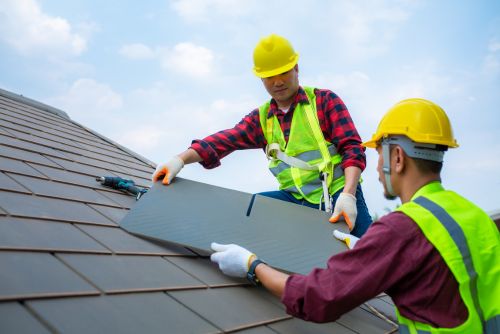
I like using high-quality roof replacement materials. Roof longevity and performance depend on the material. As an innovative homeowner, I always look for new roof materials to improve durability and energy efficiency. I find these three roofing materials intriguing:
When replacing a roof, consider how weather affects material durability and performance. Weather can significantly impact roof replacement and installation timelines. Understanding how weather affects roof replacement is crucial.
Weather conditions like rain, snow, extreme heat, and strong winds can delay roof replacement. Installation workers are at risk when rain and snow make the roof slippery. Hot weather can expand materials, making them difficult to work with. Strong winds can blow materials and tools away, creating a dangerous environment.
These weather conditions can delay roof replacement and installation. Working with a professional roofing contractor who understands these challenges and has weather mitigation strategies is essential. They can schedule the installation around the weather and protect their workers.
The roofing material also affects weather-related installation time. Some materials are more weatherproof and easier to install, while others require more time and effort.
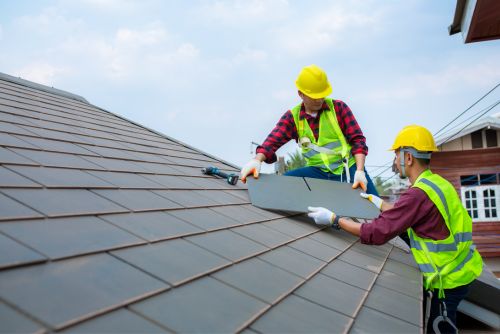
The number of contractors is important after discussing the weather’s impact on roof replacement. The number of roof replacement contractors can significantly impact completion time. Three important considerations:
Roof complexity affects the expertise and time needed for a successful replacement. Roof design and structure complexity must be considered when replacing a roof. Complex roofs with angles, slopes, and intricate details make installation harder. Roofers must be skilled and knowledgeable to handle such complexity.
The complexity of the roof affects replacement time and materials. A roof with multiple slopes and angles may need specialized materials for a good fit and durability. Since mistakes can cause leaks, complex roof installations require careful attention to detail.
Advanced roofing techniques and tools can accommodate complex roof designs, thanks to innovation. Roofers can now use drones and 3D imaging to analyze and plan for roof details before replacing them. This novel method improves preparation and installation, shortening the project duration.
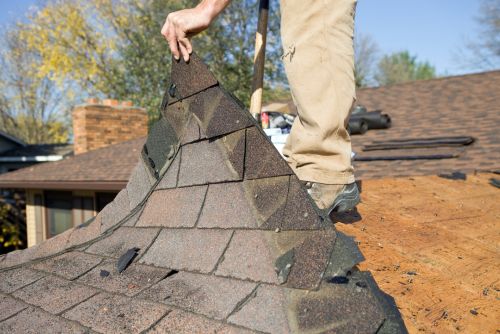
The inspection revealed extensive roof damage. This discovery has complicated roof replacement because it requires more time and attention to repair the damage. Three things to consider when replacing a roof with existing damage:
Dealing with existing damage during roof replacement may delay the project. However, addressing these key aspects creatively will result in a stronger, more resilient roof that will last.
After inspecting and documenting the damage, roof replacement requires safe and easy access. The efficiency and speed of roofing replacement depend on roof access.
As a homeowner or business owner, you may wonder, “How long does roof replacement take?” The roof’s accessibility can affect the project’s duration.
A good roofing contractor prioritizes safety and efficiency when accessing the roof. They’ll carefully assess your property’s layout to determine the best roof access method. This may require ladders, scaffolding, cranes, or lifts. The roofing contractor can simplify access and minimize disruptions to your daily routine by using innovative methods and equipment.
The roofing crew can easily transport materials and equipment to the job site with easy roof access. This streamlines replacement and reduces delays. Access helps the roofing contractor navigate the roof and finish installation or repairs faster.

To get roofing permits, I contacted the local building department. The replacement of a roof requires permits to ensure safety and compliance with building codes. Three permit and inspection considerations for roof replacement:
The first step in roof replacement is removing the old roofing material. This step ensures a clean, stable foundation for the new roof. Old roofing material removal time depends on roof size, type, and crew efficiency.
Old roofing takes a few days to a week to remove. With new technology and methods, this process can now be done faster. The new removal tools and equipment make the process faster and more efficient.
Materials may also affect removal speed. Asphalt shingles are easy to remove, but tile and metal may take longer. These factors should be considered when estimating the removal time of old roofing material.
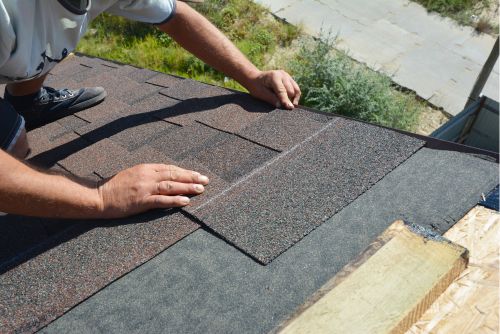
Next, new roofing material is installed for roof replacement. This exciting part of the roofing project gives your home a new, innovative look. Three important installation considerations:
Flashing and ventilation are essential to roof replacement and protecting and ventilating your home. Flashing prevents water from entering roof edges, valleys, and other vulnerable areas by installing metal sheets or strips. This novel method seals your home from leaks and damage.
Proper ventilation installation regulates attic temperature and moisture. Well-ventilated attics prevent heat and moisture buildup, which can cause mold and structural damage. Allowing air to circulate helps your roof last longer and prevent premature deterioration.
The size and complexity of your roof and the expertise of the roofing professionals determine how long flashing and ventilation installation takes. This process usually takes a few hours to two days. Flashing and ventilation must be properly installed for your roof’s long-term performance and durability, so don’t rush.
When replacing a roof, allow time for flashing and ventilation. This section emphasizes the importance of this step and its timeline impact. You can ensure your newly replaced roof provides optimal protection and ventilation for years by spending time and attention on flashing and ventilation installation.

Cleanup and debris removal follow flashing and ventilation installation in roof replacement. This crucial step ensures that your property is clean and debris-free. It beautifies your property and protects your family and neighbors. There are three main considerations during cleanup and debris removal:
Cleanup and debris removal time depends on roof size, debris amount, and weather. With careful planning and innovative methods, this step can be completed quickly and safely, keeping your property clean and safe.
After cleanup and debris removal, quality assurance and inspections are necessary to ensure the roof replacement meets the highest standards. Any roofing job requires quality assurance to ensure the new roof is durable, attractive, and long-lasting. Inspections are crucial for identifying installation issues and defects.
Quality assurance and inspection times depend on the roofing project’s size and complexity. One to two days are typical for residential projects. The newly installed roof can be thoroughly inspected to ensure it meets industry standards and specifications during this time.
For quality assurance and inspections, larger projects like commercial buildings or multi-unit complexes may take longer. The checks and assessments for these projects can take two to three days. Please note that this timeframe is an estimate and may vary depending on the project.
In the quality assurance and inspection phase, trained professionals will inspect the roof for problems. They’ll check the roof’s seal and waterproofing, materials, and structure. They’ll also check the installation for manufacturer and local building code compliance.
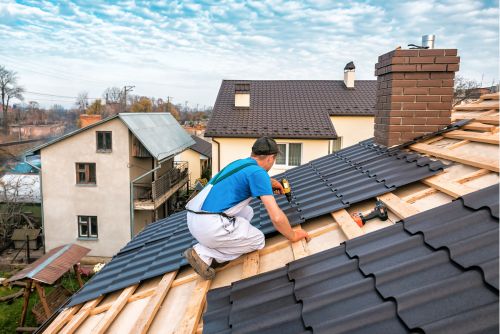
To finish the roofing project, I’ll focus on finishing touches. We innovate and create to make sure the roof serves its purpose and improves the property’s aesthetics. Three key areas need our attention:
What is involved in roofing completion, and what warranty is offered?
The completion and warranty coverage of a roof replacement job depend on several factors. First and foremost, project size and roofing system complexity determine completion time. Roof replacements typically take a few days to weeks. Some companies can finish faster with new roofing methods and materials.
Understanding the warranty after the roof replacement is crucial. Most reputable roofing companies offer material and installation warranties. Warranty length usually ranges from 10 to 30 years. This warranty reassures homeowners that roof defects are covered.
How long the warranty is and what’s covered are also important. The warranty usually covers material and installation defects. To understand the warranty’s terms and exclusions, read it carefully.
In conclusion, the duration of a roof replacement project depends on several factors such as:
Additionally, quality assurance inspections, final touches, and finishing details should be taken into account. Once all these aspects are considered and completed, the project will be finished and covered by warranty. Now you already have an idea on how long does it take to replace a roof.
There are various types of roofing materials available, each with its own pros and cons. Some common options include asphalt shingles, which are affordable but may not last as long as other materials.
Metal roofs are durable and energy-efficient, but can be more expensive. Tile roofs offer a unique aesthetic and excellent durability, but can be heavy and require additional structural support.
I visually inspect my roof to check for damage. Look for missing or damaged shingles, sagging areas, or ceiling water stains. I also inspect the attic for leaks and water damage.
If I see any problems, I call a roofing contractor to assess the damage and recommend repairs or replacements. To avoid complications, fix the roof damage immediately.
Roof replacement requires permits and inspections. This ensures code compliance and safety.
Permits and inspections protect homeowners from future issues. Following proper procedures ensures that your roof replacement is done right and lasts for years. It may take longer, but peace of mind is worth it.
The replacement of a roof requires removing the old roofing material. It takes time to carefully remove old shingles, nails, and other debris.
This process requires precision and attention to detail to prepare the roof for new materials. This step lays the groundwork for a successful roof replacement, so take your time.
Installing flashing and ventilation on a new roof is essential for its longevity and efficiency.
Proper flashing prevents water leaks and protects vulnerable areas, while ventilation circulates air and regulates temperatures. This meticulous installation involves assessing the roof’s needs, choosing the right materials, and expertly positioning and securing them.